Гуань Инь

Гуань Инь, Богиня Милосердия. В Буддизме Гуань Инь почитают как сострадательную спасительницу, бодхисаттву милосердия. Гуань Инь – возлюбленная мать и божественная посредница, близкая к повседневным делам своих приверженцев, является буддистской Мадонной, чья роль на Востоке сравнима с ролью, которую Мать Мария играет на Западе. По всему Дальнему Востоку почитающие ее люди стремятся обрести ее помощь и руководство в каждой сфере жизни. Алтари, посвященные Гуань Инь, можно найти в храмах, домах и придорожных капищах.
Имя Гуань Ше Инь, как ее часто называют, означает «та, кто наблюдает за миром, или прислушивается к звукам мира». Согласно легенде, Гуань Инь собиралась войти в царство небесное, но остановилась на пороге, услышав плач мира.
Гуань Инь почитают как покровительницу женщин, моряков, торговцев, ремесленников, тех, кто подвергается уголовному преследованию, а также желающих иметь потомство. [В сердцах людей] живет непоколебимая вера в спасительную благодать и целительные силы Гуань Инь. Многие полагают, что даже простое повторение имени Гуань Инь мгновенно привлечет ее присутствие. Кристаллический Розарий Гуань Инь содержит ее мантры и является мощным средством для привлечения ее заступничества.
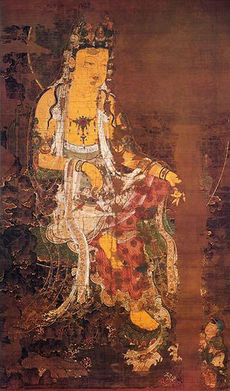
Traditions in the East
Для буддизма Махаяны Гуань Инь на протяжении многих столетий является олицетворением идеала бодхисаттвы. Слово «бодхисаттва» буквально означает «существо бодхи», «просветленное существо», существо, которому предопределено стать Буддой, но кто отказался войти в блаженство Нирваны, дав обет спасти всех детей Бога. Гуань Инь принесла обет бодхисаттвы работать с эволюциями этой планеты и этой солнечной системы, показывая им путь учений Вознесенных Владык.
В традиции буддизма Гуань Инь представляет собой китайский эквивалент в женской форме Бога Милосердия и Сострадания Авалокитешвары, которого почитали в Индии и Тибете до проникновения буддизма Махаяны в Китай в пятом веке. Приверженцы призывают силу и милосердное заступничество бодхисаттвы, произнося мантру «Ом Мани Падмэ Хум» – «Привет тебе, драгоценность в лотосе», или, как часто переводится, «Привет тебе, Авалокитешвара, кто является драгоценностью в лотоса сердца верующего»!
Согласно легенде, Авалокитешвара родился из луча белого света, вышедшего из правого глаза Амитабхи, Будды Безграничного Света, когда тот был погружен в экстаз. Таким образом, Авалокитешвару (Гуань Инь) считают «отображением » Амитабхи – следующей эманацией или воплощением маха каруны (великого сострадания) – качества, которое сам Амитабха воплощает в высшем смысле. Приверженцы считают, что Гуань Инь в роли милосердной избавительницы более непосредственным и личным образом выражает сострадание Амитабхи, и что на молитвы, обращенные к ней, ответ приходит быстрее.
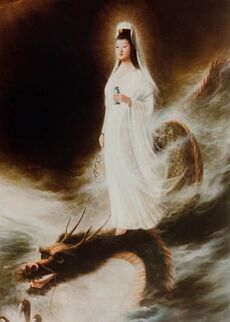
In the Pure Land sect of Buddhism, Kuan Yin forms part of a ruling triad that is often depicted in temples and is a popular theme in Buddhist art. In the center is the Buddha of Boundless Light, Amitabha (Chinese, A-mi-t’o Fo; Japanese, Amida). To his right is the bodhisattva of strength or power, Mahasthamaprapta, and to his left is Kuan Yin, personifying his endless mercy.
In Buddhist theology Kuan Yin is sometimes depicted as the captain of the “Bark of Salvation,” guiding souls to Amitabha's Western Paradise, or Pure Land—the land of bliss where souls may be reborn to receive continued instruction toward the goal of enlightenment and perfection. The journey to Pure Land is frequently represented in woodcuts showing boats full of Amitabha’s followers under Kuan Yin’s captainship.
One of Kuan Yin’s principal emblems is the willow branch. According to Buddhist belief, she uses the willow branch to drive away illness and to sprinkle the nectar of wisdom and compassion upon all who invoke her assistance. In some Asian traditions prayers to cure disease were given while stroking the afflicted person with a willow branch.
Kuan Yin is considered to be the bestower of children, and so she is often depicted with an infant. In Taiwan there is also a legend that in one of her embodiments she was a mother and therefore is shown with her own child.
Kuan Yin is also often depicted standing on a dragon. The dragon for the Chinese people represents China and their divine lineage. It is also a symbol of the entire Spirit of the Great White Brotherhood. In its antithesis, the dragon is seen in the Book of Revelation giving power to the beasts. So a dragon is a thoughtform of a great hierarchy—whether embodying the forces of Light or the forces of Darkness.
In Chinese lore the dragon and the phoenix bird together represent the yang and yin of the whirling T’ai Chi. So the image of Kuan Yin riding a dragon shows her having dominion over that dragon in the sense of being the master of it.
Miao Shan
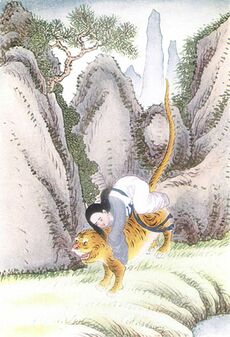
It is widely believed that Kuan Yin took embodiment as the third daughter of Miao Chuang Wang, identified with the Chou dynasty, a ruler of a northern Chinese kingdom about 700 B.C. The king had seized his throne by force of arms, and he desperately desired a male heir to succeed him. Instead he had three daughters. The youngest, Miao Shan, was a devout child who “scrupulously observed all of the tenets of the Buddhist doctrines. Virtuous living seemed, indeed, to be to her a second nature.”[1]
She recognized the impermanence of riches and glory and desired nothing more than “a peaceful retreat on a lone mountain.” She told her sisters that “If some day I can reach a high degree of goodness.... I will rescue my father and mother, and bring them to Heaven; I will save the miserable and afflicted on earth; I will convert the spirits which do evil, and cause them to do good.”
Miao Shan’s father determined to find a husband for her who would be capable of ruling the kingdom. The king explained his plans and told her that all his hopes rested on her. Miao Shan said that she did not wish to marry because she desired to attain perfection and Buddhahood.
The king was angry. “Has anyone known the daughter of a king to become a nun?” he asked. Then he demanded that she marry an academician or a military man at once. Recognizing that she could not openly disobey her father’s orders, Miao Shan said that she would immediately marry a physician since she could then still become a Buddha. Outraged, the king ordered his officer to take her to the Queen’s garden “and let her perish there of cold.”
Miao Shan retired to the garden glad to exchange the pleasures of the palace for the sweetness of solitude. Her parents, sisters and the ladies of the court tried in vain to dissuade Miao Shan from her purpose. Instead she asked her father’s permission to live at the Nunnery of the White Bird. The king consented but sent strict orders to the nunnery that the nuns should do all in their power to persuade Miao Shan to leave.
The nuns tried but failed. They then decided to put Miao Shan in charge of the kitchen where, if she failed, they could dismiss her. Miao Shan so joyously agreed that she touched the heart of the Master of Heaven who ordered the spirits of heaven to assist her in her duties.
The Superior of the nunnery then asked the King to recall his daughter. The king sent five thousand soldiers to surround the Nunnery of the White Bird and burn it to the ground along with the nuns. The nuns invoked the aid of Heaven but said to Miao Shan: “It is you who have brought upon us this terrible disaster.”
Miao Shan agreed that it was so. She knelt and prayed to Heaven and then pricked the roof of her mouth with her bamboo hairpin and spat the flowing blood toward heaven. Great clouds immediately gathered and showers put out the fire threatening the nunnery. The nuns threw themselves on their knees and thanked Miao Shan for saving their lives.
The king, informed of this miracle, was enraged and ordered the chief of the guard to immediately behead Miao Shan. As the execution was to begin, the sky became overcast, but a bright light surrounded Miao Shan. When the executioner’s sword fell upon her neck, it broke. A spear thrust at her fell to pieces.
The king ordered that she be strangled with a silken cord. But a tiger leaped into the execution grounds, dispersed the executioners, put the inanimate body of Miao Shan on his back and disappeared into the pine forest.
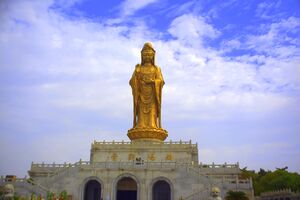
Miao Shan’s soul, which was not hurt, was taken to the lower world, hell. She prayed and hell was transformed into a paradise. She was sent back to earth to resume her life there. Carried on a lotus flower to the island of P’u-t’o Shan—the sacred island-mountain in the Chusan Archipelago off the coast of Chekiang—she lived for nine years healing the diseased and saving mariners from shipwreck.
Говорят, что однажды, когда до нее дошел слух о болезни отца, она срезала плоть со своих рук и использовала как лекарство для спасения его жизни. В благодарность он приказал создать в ее честь статую, поручив скульптору изобразить ее с «совершенной формы руками и глазами». Однако скульптор понял неверно, и по сей день Гуань Инь подчас изображают «тысячерукой и тысячеокой», способной, таким образом, видеть множество людей и помогать им.
During the twelfth century Buddhist monks settled on P’u-t’o Shan, and devotion to Kuan Yin spread throughout northern China. This picturesque island became the chief center of worship of the compassionate Saviouress; crowds of pilgrims would journey from the remotest places in China and even from Manchuria, Mongolia and Tibet to attend stately services there. At one time there were more than a hundred temples on the island and over one thousand monks. The lore surrounding P’u-t’o island recounts numerous appearances and miracles performed by Kuan Yin, who, it is believed, reveals herself to the faithful in a certain cave on the island.
The bodhisattva ideal
Служение Гуань Инь очень реально и старо как мир. Данный бодхисаттвой обет остаться вместе с человечеством, является священным призванием. Однако Гуань Инь предостерегает нас от принесения этого обета, если мы не вполне понимаем служение этих преданных:
Being one with all life, we are aware of all life in its manifestation from the highest to the lowest. This is part of the bodhisattva ideal, which is a part of those who are standing with humanity. And there are quite a number upon this planet, although few compared to those who go their own way of riotous living. It is a very high and holy order, and I suggest that you think long and hard about this calling before you respond and say, I will do the same!”
Ведь когда пройдет целая вечность, а люди не отзовутся на хранимое вами пламя, знайте, что вы можете пожалеть, что не избрали другой, более легкий и благодарный путь. Когда проходят столетия, тысячелетия и циклы, а те же самые индивидуумы, кого вы питали силой своего сердечного пламени, вовлечены во все те же мирские утехи, вы обнаруживаете, что вопиете к Богу: «О ГОСПОДИ, сколь долго, сколь долго этот упрямый род будет идти к знанию о своей божественности и о любви к священному огню, который мы хранили столько лет?»[2]
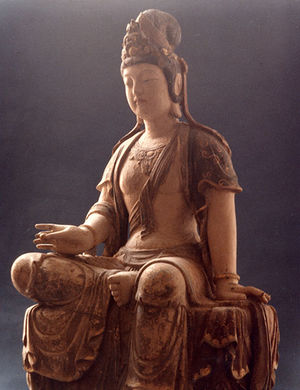
The mercy flame
Гуань Инь представляет качества милосердия и сострадания для эволюций Земли. Пламя милосердия – это средство, позволяющее Христу вступиться за тех, кто совершил прегрешения, но не может за каждое нарушение нести всю тяжесть скорого возмещения, которого требует Закон. Милосердие замедляет возвращение кармы человечества, сдерживая руку правосудия до того времени, когда индивидуумы смогут встать, встретиться лицом к лицу со своим собственным человеческим творением и победить его. Гуань Инь говорит нам, что
милосердие – это качество любви, которое сглаживает шероховатости жизни, исцеляет раны эфирного тела, заделывает трещины в уме и чувствах, выметает осколки греха и чувство напряжения прежде, чем они проявятся в физическом теле как болезнь, увядание, разрушение и смерть[3].
«Милосердие – это величайшая сила во вселенной, – говорит Гуань Инь, – это сила Божьей воли… Сила милосердия – в интенсивной любви, которая растворит весь страх, все сомнение, непокорность и мятеж в народе… Милосердие Закона подчас очень сурово, но всегда терпеливо, всегда терпимо, и оно помогает пламени внутри сердца подниматься, подниматься и подниматься, чтобы встретить Христа».[4]
Гуань Инь напоминает нам: «Когда вы ощущаете необходимость в большей силе, большем просветлении, большей чистоте и исцелении, помните, что все эти качества вы получаете из сердца Бога благодаря действию самого пламени милосердия. Ведь через прощение приходит обновленная возможность исполнить Закон, а без прощения успехи будут весьма незначительны».[5] Поэтому, чтобы снова обрести связь с Богом, нам необходимо прощение.
The need for forgiveness
Когда мы призываем его, давайте осознавать, что наше Я Христа является нашим психиатром, нашим психологом, нашим священником, нашим жрецом, нашим раввином, нашим другом, тем, к кому нам следует ежедневно приходить, чтобы снять с себя бремя, как это делали американские индейцы. Вечером они образовывали круг вокруг костра и обсуждали произошедшие за день события. И все, что им не нравилось, они бросали в пламя. Это тот же принцип, которому учит каждая религия мира. Когда мы помещаем произошедшие негативные события в пламя, мы ложимся спать в состоянии мира. Во многих случаях бессонница вызвана тем, что мы не освобождаемся от кармы и бремени дня, а потому не находимся в мире с самими собой и с Богом.
Мы нуждаемся в раскаянии, нуждаемся в том, чтобы поведать Богу о своих поступках, не согласующихся с Его Законом. До тех пор, пока мы не скажем Ему об этом и не попросим Его пламя прощения пройти через нас, мы будем жить с чувством вины, страха, стыда и, более всего, с чувством своей отделенности от Него. Сегодня это проявляется во всевозможных ментальных и эмоциональных расстройствах, в раздвоении личности, проявлениях ненависти к отцу и матери, к детям и во многих других проблемах, жертвой которых стало современное общество. Путь назад к гуру – Внутреннему Христу – ведет через обращение к закону прощения.
Прощение – это нечто, что нам необходимо призывать не только для себя, но и для каждой частицы жизни, для всех, кто когда-либо причинил нам зло и кому причинили зло мы. Сен-Жермен учит нас, что, когда мы призываем прощение, мы делаем это, побуждаемые горячей любовью своего сердца. Нам необходимо сообщать друг другу, что мы простили и просим прощения. Вы проявляете смирение, когда говорите: «Я поступил неверно, и я прошу тебя и Бога простить меня».
Когда мы призываем закон прощения, он вспыхивает в ауре фиолетовым, лиловым и розовым светом, словно фейерверк, растворяя неприятные состояния в нашем мире. И этот фейерверк начинает усиливаться, пока огромные сферы энергии не начинают исходить из нашего сердца, наполняя мир. Вы можете визуализировать любимого человека, ребенка, мнимого врага, политического деятеля, вы можете представлять целый город, правительство, всю страну или планету внутри этой сверкающей сферы пламени милосердия принимающими одну за другой волны прощения.
Прощение – это закон, и согласно этому закону, наши грехи откладываются, чтобы предоставить возможность развить Христо-сознание. «Обучение закону прощения необходимо, – наставляет нас Гуань Инь, – ибо, воистину, это – основание для века Водолея… Прощение не есть уравновешивание кармы; это временное откладывание кармы, благодаря чему вы получаете свободу для движения вперед, преодоления, исправления ошибок, не неся при этом того тяжкого бремени, того груза греха. И когда вы приходите к точке обретения большего достижения, то, согласно закону прощения, временно отложенная карма возвращается вам. И в достигнутом вами более высоком состоянии сознания на плане самоовладения вы способны быстро поместить эту субстанцию в пламя для трансмутации и следовать своему высокому призванию».[6]
Существует различие между прощением грехов и их трансмутацией. Например, кто-то может украсть у вас кошелек и позже сказать вам, что он сожалеет об этом. Вы можете простить его, но вопрос, с кармической точки зрения, не закрыт до тех пор, пока он не возвратит вам этот кошелек со всем его содержимым до последней копейки или же, если потребуется, не возместит убытки в каком-то ином виде. Прощение не уравновешивает карму, а временно откладывает ее, давая вам возможность исправить ошибки, не будучи обремененными тяжестью греха.
Основанием пути изобильной жизни, как и этой науки, является прощение. Это восстановление гармонии между всеми частями жизни. Это интенсивное любящее действие пламени свободы. Энергии фиолетового пламени, энергии Бога всегда пульсируют, всегда в движении, трансмутируя записи подсознания. Прощение – это исполнение закона, записанного в книге Исаии: «Если будут грехи ваши, как багряное, – как снег убелю; если будут красны, как пурпур, – как волну убелю».[7]
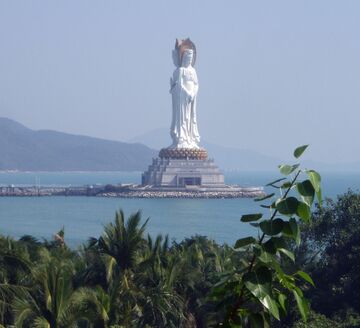
The need to forgive
If you expect forgiveness, then you must be ready to forgive seventy times seven, as the Master Jesus taught. “In small ways and in great ways, mankind are tested,” Kuan Yin says, “And the bigotry that remains in the consciousness of some is also a lack of forgiveness. Those who cannot forgive their fellowmen because they do not think or worship as they do—these have the hardness of heart that encases the flame of love and also prevents the flow of wisdom.”[8]
The mercy of the law is like a two-way street. It is the signal that you send to God and the signal that he returns. A two-way street means the give-and-take with God. If you expect mercy from God, then you must give mercy to every part of life. The fulfillment of the law of mercy must be for the ultimate liberation of each and every soul. Thus, as we forgive life, life forgives us.
Time and time again we have all heard the cliché, “Let bygones be bygones. Forgive and forget!” This is so true, because if you can still resurrect the memory of a wrong that has been done to you, then you have not truly forgiven. In order to forgive, the record and the memory must be dissolved from your consciousness. Kuan Yin tells us that if this is not the case, not only have you not truly forgiven, but “you have hardened your heart. You have stored the record as a squirrel with his nuts deep within the subconscious. Deep in the etheric plane, you have stored the record of that wrong. You have not released it into the flame. You have not been willing to let go and let God be free to express in those who have wronged you, in those whom you have wronged.”[9]
One of the best ways to accomplish this complete “forgiving and forgetting” is by the use of the science of the spoken Word, accompanied by visualization, in a mantra for forgiveness written by El Morya in his “Heart, Head and Decrees.”
- I AM forgiveness acting here,
- Casting out all doubt and fear,
- Setting men forever free
- With wings of cosmic victory.
- I AM calling in full power
- For forgiveness every hour;
- To all life in every place
- I flood forth forgiving grace.
As you give this prayer daily, you may wish to visualize the flames of mercy, which are a lovely pink-violet color, enfolding your being and removing the cause and core of many wrongs of the past. It is possible to experience a great sense of relief from burdens you may have been carrying for centuries as you call for forgiveness for your sins—even those of which you may not be aware in this embodiment—and then truly accept God’s grace and forgiveness that he is extending to you through the gift of his violet transmuting flame.
The color violet has many hues ranging from the orchid-pink of mercy’s flame, containing a greater saturation of the pink ray of God’s love, to the deep-purple flame that embodies more of the blue of the will of God. The purple flame has a greater electronic cleansing action, which, when used alternately with the healing green decrees, will effectively purify and heal the four lower bodies, especially the etheric body (the memory body) of the records of the past that may be buried deep within the subconscious. To invoke this flame, take any violet-flame decree and substitute the word “purple” for “violet.” Oftentimes it is more difficult to penetrate to the etheric body than to any of the other lower bodies, and therefore the repetition of a mantra thirty-six times can be very effective in clearing old records of past momentums.

Service on the Karmic Board
Kuan Yin reminds us of another facet of the flame of mercy as she says:
For many of you I have pleaded before the Lords of Karma for the opportunity to embody, to be whole, to not have dealt to you in the physical the great karma of being maimed and blinded at birth that some of you have deserved. I have interceded with the flame of mercy on your behalf so that you could pursue, in the freedom of a sound mind and body, the light of the Law. Some who have been denied that mercy by the Lords of Karma are today in the institutions for the insane; for them it was meted that they should experience the agony of the absence of the presence of the Christ mind, that they might know what it is to defile that mind, that they might return in another life and appreciate the gift of reason, the gift to pursue the Holy Word Incarnate by the power of the Logos.
You do not realize how much has hung in the balance of your own life because mercy’s flame has been available to you. You have called and God has answered, and through my heart and my hands, mercy has flowed. I say this that you might also have the wisdom to understand that when mercy has been accorded for a time, you are expected to deliver the fruits of mercy, following the works of the LORD and the way of wisdom.[10]
The Bodhisattva Kuan Yin is known as the Goddess of Mercy because she ensouls the God-qualities of mercy, compassion and forgiveness. She serves on the Karmic Board as the representative of the seventh ray (violet ray). She also held the office of chohan of the seventh ray for two thousand years until Saint Germain assumed that office in the late 1700s.
Her retreat
► Main article: Temple of Mercy
Kuan Yin ascended thousands of years ago and has taken the vow of the bodhisattva to serve planet Earth until all her evolutions are free. From her etheric retreat, the Temple of Mercy, over Peking (Beijing), China, she ministers to the souls of humanity, teaching them to balance their karma and fulfill their divine plan through loving service to life and application of the violet flame.
Kuan Yin’s flame is the color of orchids, the pink of divine love tempering the blue of the will of God. Her flower is a pink and violet lotus; the center, being pink, is as the mercy flame, becoming deeper and deeper violet on the periphery.
See also
Sources
Mark L. Prophet and Elizabeth Clare Prophet, The Masters and Their Retreats, s.v. “Kuan Yin.”
Kuan Yin’s Crystal Rosary booklet, introduction.
Elizabeth Clare Prophet, July 1, 1988.
Elizabeth Clare Prophet, July 5, 1996.
- ↑ This account is adapted from Edward T. C. Werner, Myths and Legends of China (London: Harrap, 1922), chapter X.
- ↑ Kuan Yin, “The Quality of Mercy for the Regeneration of the Youth of the World,” Pearls of Wisdom, 1982, Book II, pp. 120–21.
- ↑ Гуань Инь, «Народ и учение, время которых пришло», 18 сентября 1976 г.
- ↑ Гуань Инь, «Меч милосердия», 10 октября 1969 г.
- ↑ Kuan Yin, “Karma, Mercy, and the Law,” Pearls of Wisdom, 1982, Book II, p. 106.
- ↑ Kuan Yin, “A Mother’s-Eye View of the World,” Pearls of Wisdom, 1982, Book II, p. 87.
- ↑ Исаия 1:18.
- ↑ Kuan Yin, “Mercy: The Fire that Tries Every Man’s Works,” Pearls of Wisdom, 1982, Book II, p. 95.
- ↑ Kuan Yin, “A Mother’s-Eye View of the World,” Pearls of Wisdom, 1982, Book II, p. 87.
- ↑ Kuan Yin, “Mercy: The Fire that Tries Every Man’s Works,” Pearls of Wisdom, 1982, Book II, p. 96.
